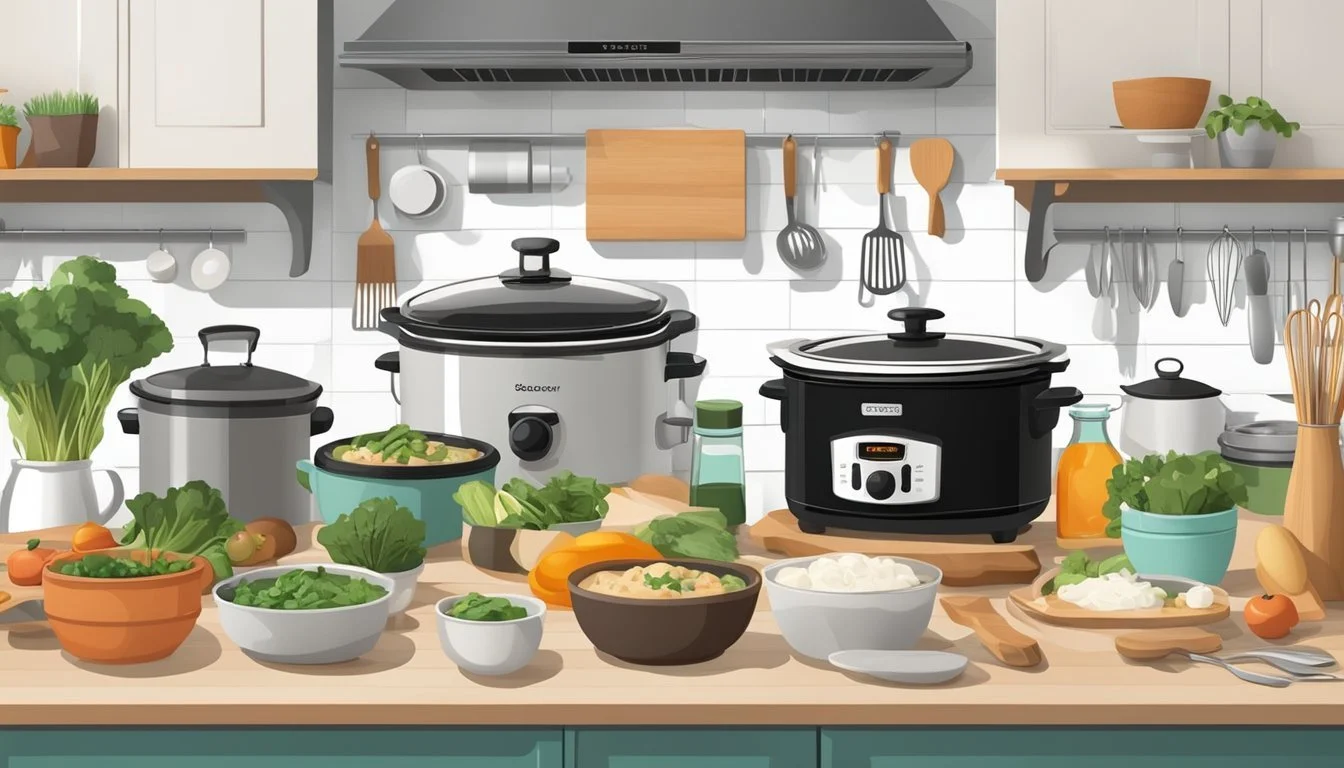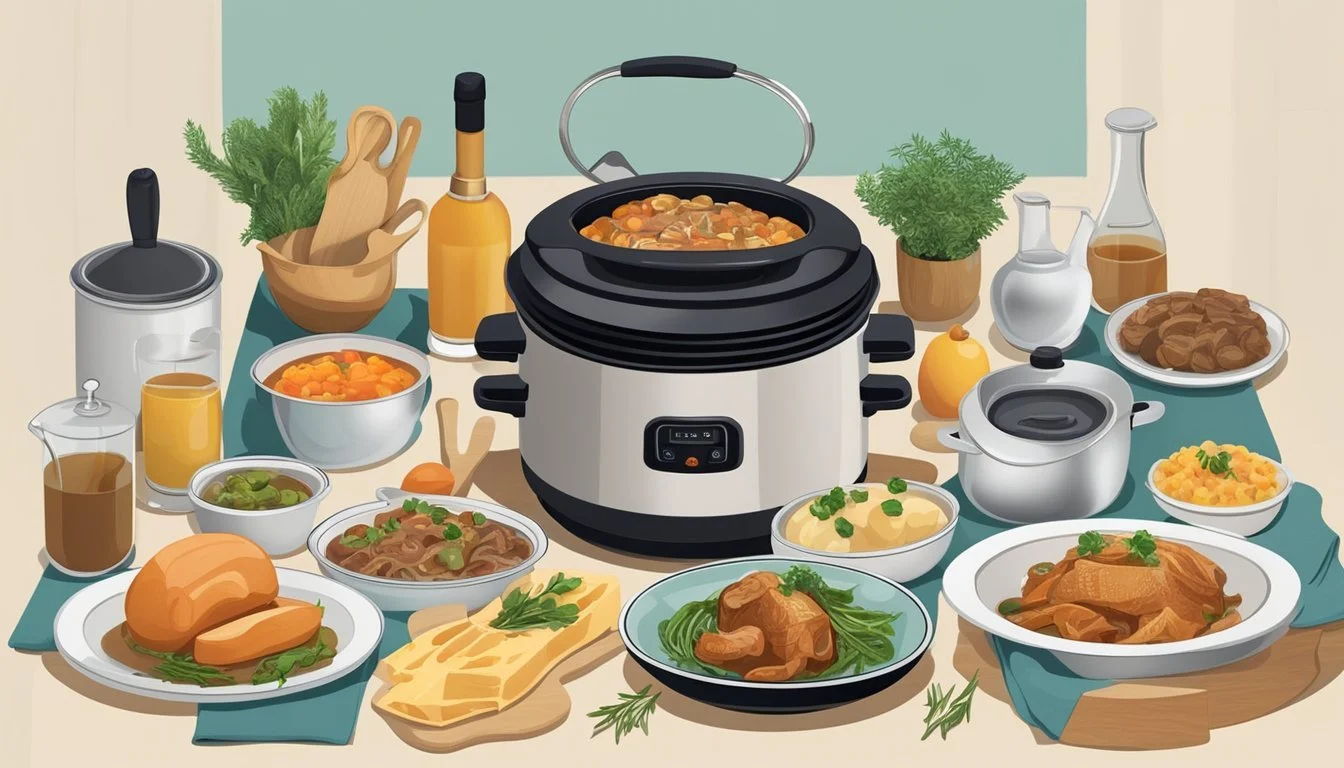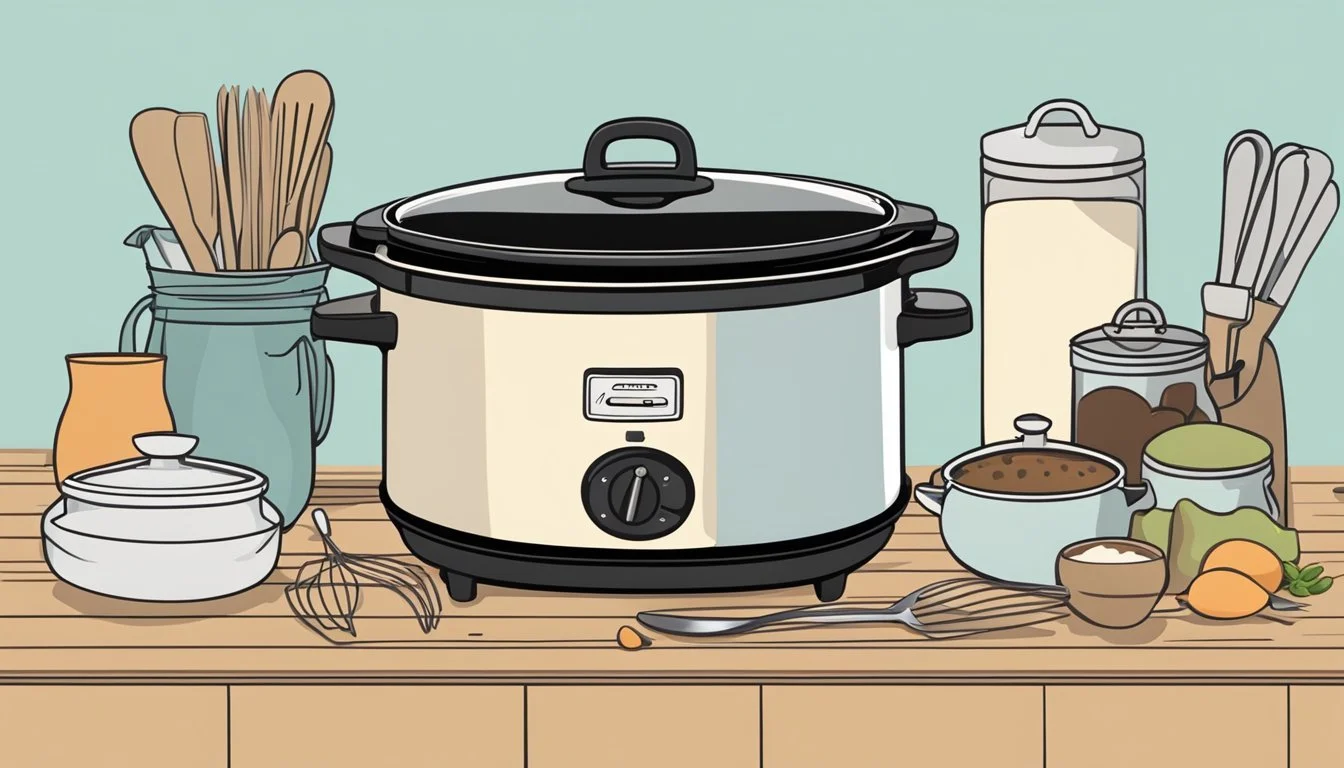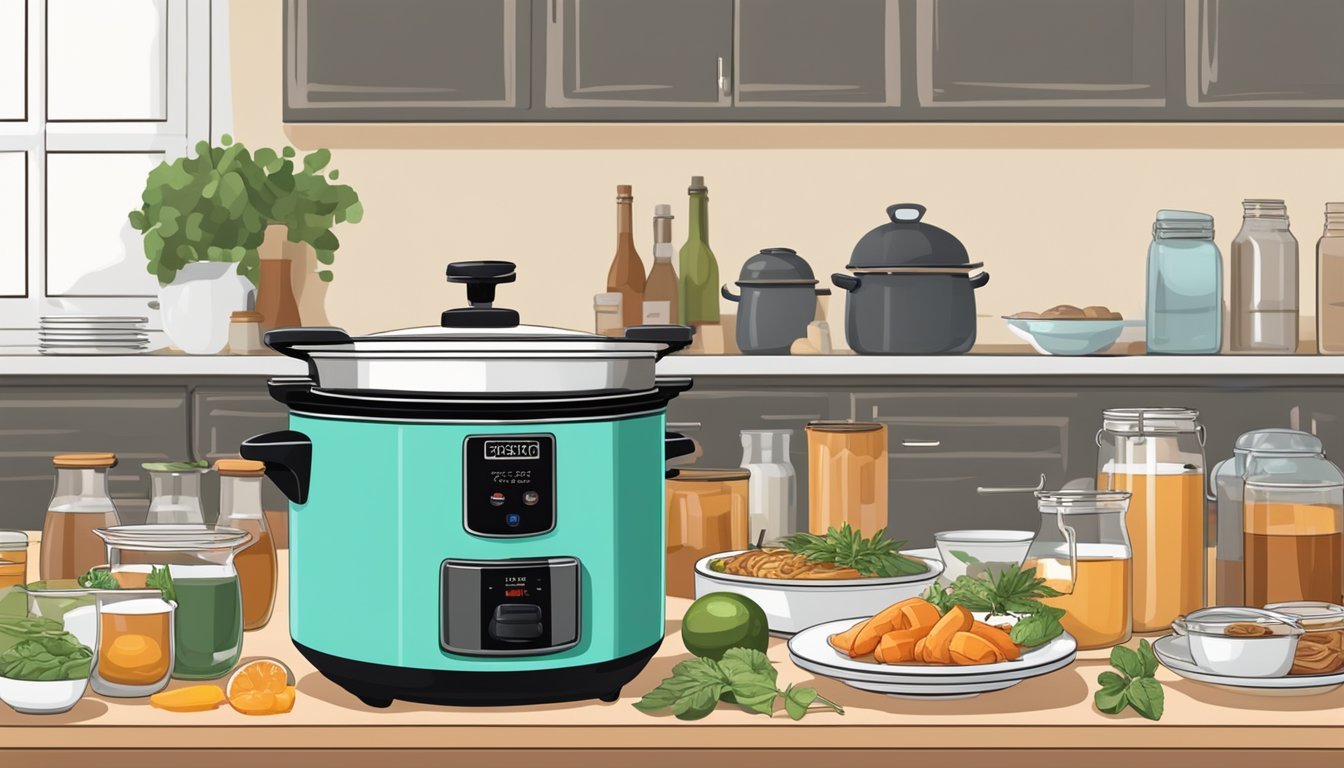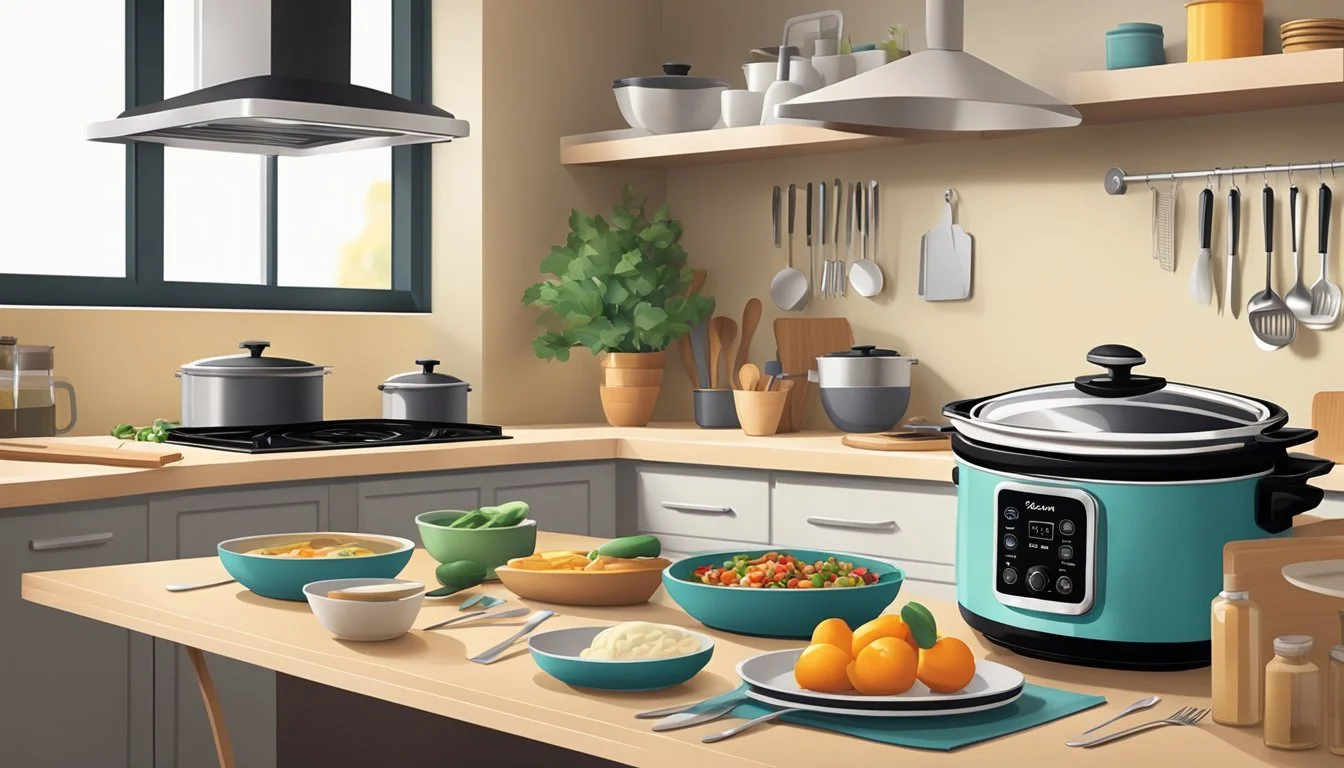How to Organize Your Kitchen for a Dinner Party with a Slow Cooker
Streamlined Strategies
Organizing a kitchen for a dinner (What wine goes well with dinner?) party can be a daunting task, but the strategic use of a slow cooker offers a practical and efficient solution. Slow cookers are renowned for their convenience, allowing hosts to prepare dishes hours in advance and thus freeing up precious time and space for other party preparations. As these appliances gently simmer the food, they enhance flavors and tenderize meats, making them ideal for creating a range of delicious and satisfying dishes that are sure to impress guests.
When planning a dinner party, the host should consider menu items that can be easily prepared in a slow cooker. Hearty stews, fragrant curries, and tender roasts are all excellent choices for a main course, and can be left to cook without constant monitoring. This allows the host to focus on setting the table, arranging decorations, and attending to guests. Moreover, the slow cooker can be used for more than just the main course; appetizers (What wine goes well with appetizers?), side dishes, and even desserts can be crafted within the versatile ceramic confines of the cooker.
For a successful dinner party, the kitchen must be organized efficiently. Ingredients for slow cooker dishes can be prepped in advance and stored in the refrigerator until needed. The slow cooker itself should be positioned on a flat surface, away from high traffic areas, yet accessible for serving. By incorporating this appliance into the dinner party preparations, the host can ensure a warm and welcoming atmosphere, presenting sumptuous meals that are prepared with minimal stress and maximum flavor.
Planning Your Dinner Party Menu
When one prepares a dinner party menu, selecting the right mix of slow cooker recipes and complementary dishes ensures a stress-free and enjoyable dining experience.
Selecting a Theme for Cohesiveness
Choosing a theme for the dinner party guides the menu selection towards a cohesive experience. It helps in creating an atmosphere and making food choices that complement each other. A theme could be as simple as "Italian Night" or as specific as "Caribbean Cruise," which would then influence the type of dishes prepared.
Choosing Slow Cooker Recipes
Opting for slow cooker recipes is a strategic move that ensures dishes are prepared with minimal supervision while providing a depth of flavor. The host should select recipes that are known for their ease and ability to be cooked in a crockpot. Examples of main dishes include Beef Bourguignon (What wine goes well with beef bourguignon?) or Vegetarian Chili. (What wine goes well with vegetarian chili?) For appetizers, one might consider a Slow Cooker Spinach and Artichoke Dip (What wine goes well with spinach and artichoke dip?).
Slow Cooker Main Dishes:
Beef Bourguignon
Vegetarian Chili
Slow Cooker Appetizers:
Spinach and Artichoke Dip
Balancing the Menu with a Variety of Dishes
Ensuring a variety of dishes means the guests will experience a balanced meal with appetizers, a main dish, side dishes, and desserts. Side dishes should complement the slow cooker centerpiece without stealing the spotlight. An example would be serving Garlic Mashed Potatoes with slow-cooked Beef Stew. (What wine goes well with beef stew?) For desserts, a simple yet refined choice could be a Crockpot Molten Chocolate Cake.
Recommended Side Dishes:
Garlic Mashed Potatoes
Honey Glazed Carrots
Dessert Options:
Crockpot Molten Chocolate Cake
Berry Crisp
Preparing the Slow Cooker
Organizing a dinner party with a slow cooker can make cooking a breeze, but it starts with proper preparation. The following steps ensure that the slow cooker is set up safely, efficiently, and ready to handle all the dishes on the menu.
Essential Slow Cooker Settings
Every chef should be familiar with their slow cooker's basic settings. Generally, there are at least two: Low and High. Cooking on Low typically takes about 8 hours, which is ideal for tenderizing tougher cuts of meat and developing flavors. The High setting cuts cooking times in half, suitable for faster cooking needs. Some recipes require starting on High and later switching to Low, so it's essential to plan the timing accordingly.
Advanced Slow Cooker Techniques
Mastering a slow cooker involves more than setting and forgetting. For complex flavors or specific textures:
Use the Low setting for longer cooking times to allow flavors to meld together.
Layer ingredients correctly—root vegetables at the bottom, then meats, and delicate items on top.
Brown meats before adding them to the pot to lock in flavor and improve texture.
Implementing these techniques can elevate even the most straightforward recipes.
Food Safety Measures
Food safety is paramount when using a slow cooker. To ensure safe cooking temperatures are reached and maintained:
Preheat the slow cooker if the recipe requires—add water and set it to the desired temperature before adding ingredients.
Avoid overfilling the cooker; it should be filled to just half to two-thirds to ensure even cooking.
Use a food thermometer to check that meats reach a safe internal temperature—for poultry, that's 165° F; for beef, pork, and lamb, 145° F with a 3-minute rest time.
By adhering to these measures, the chef can ensure that dishes are not only delicious but also safe for guests to enjoy.
Pre-party Kitchen Organization
When planning for a dinner party using a slow cooker, well-organized cooking stations and optimal counter space usage are vital. One must ensure that everything needed for the preparation, cooking, and serving of the meal is efficiently arranged.
Arranging Cooking Stations
In a kitchen, designate a specific area for the slow cooker that's close to electrical outlets and away from high traffic zones to prevent accidents or spills. Cookware, utensils, and ingredients for the slow-cooked meal should be gathered in this area. A nearby cutting station, ideally on a large chopping board, allows for efficient prepping of ingredients. It is beneficial to have the following items within arm's reach:
Cutting utensils: Knives, peelers, and scissors.
Measuring tools: Measuring cups and spoons.
Prep bowls: Separate bowls for prepped ingredients.
Optimizing Counter Space
Maximize counter space by decluttering unnecessary items and only keeping essentials on the surface. Appliances not in use for the party can be temporarily stored away. Utilize vertical space with stackable racks for plates and use drawer organizers to keep utensils neatly sorted. Here are ways to optimize the space:
Clearing Clutter: Remove non-essential items from counters.
Storage Solutions: Employ multi-tiered shelves for ingredients.
Workspace Consolidation: Dedicate areas for specific tasks like chopping, assembling, and platting.
Every inch of counter space is valuable, so consolidation is key for a streamlined cooking experience during a dinner party.
Creating a Shopping List
A well-organized shopping list is crucial for ensuring the kitchen is adequately prepared for a dinner party. It prevents the stress of last-minute dashes to the store and assures that each dish, from appetizer to dessert, is accounted for.
Ingredients for Each Dish
The shopping list should begin with a breakdown of each dish on the menu. For example, if the party features chicken thighs (What wine goes well with chicken thighs?) as the main dish, rice and beans as side dishes, and a corn and pepper salad, the list must include all the required ingredients. A slow cooker recipe for chicken thighs will necessitate chicken, onions, garlic, and any specific spices like salt, pepper, or sugar for glazing.
Main Dish: Chicken thighs, onions, garlic, salt, pepper
Side Dish (Rice and Beans): Rice, beans, green onions, bell peppers
Side Dish (Salad): Corn, peppers, green onions, salad dressing
Dessert: Ingredients will vary based on the chosen dessert
Be specific about quantities; for example, listing '2 lbs of chicken thighs' or '3 bell peppers'. Including the quantity of each item is essential for recipe accuracy.
For dishes that require longer cooking times or marination in the slow cooker, ensure all ingredients are listed to prepare ahead of schedule.
Estimating Quantities for Guests
Calculating the necessary amounts of each ingredient is dependent upon the number of guests attending the party. A common rule is to assign a half-pound of the main dish meat per person, a cup of side dishes like rice and beans, and allocating one to two pieces of bread per guest. For appetizers and desserts, consider the number of guests and the variety of options available.
Appetizer: Choose quantities that allow for 3-5 pieces per guest.
Main Dish: 1/2 lb chicken thighs per guest
Side Dishes: 1 cup per side dish per guest
Desserts: If offering one dessert, ensure there is a serving for each guest.
Remember to adjust for courses like cheese and tortillas that may accompany the meal. Always round up your estimates to accommodate for unexpected guests or larger appetites. It is better to have leftovers—organized in Tupperware for easy storage or to send home with guests—than to run short during the event.
Cooking Timeline
When planning a dinner party with a slow cooker at the helm, the cook must optimize the kitchen timeline to ensure each dish is given the attention it needs. Slow cookers afford a hands-off approach to cooking mains and sides, but knowing when to start and what to prep in advance ensures a seamless party.
Prioritizing Slow Cooker Dishes
To effectively manage a dinner party, one should select easy slow cooker recipes that allow for both mains and sides to be cooked to perfection. Mains like chicken satay (What wine goes well with chicken satay?) curry or tender beef should be started 4-6 hours in advance, depending on the heat setting used. Sides such as a creamy potato bake could be cooked alongside in a separate slow cooker if available or scheduled to finish before the main is served, to avoid clashing timings.
4-6 hours before guests arrive: Begin cooking the main dish in the slow cooker.
3-4 hours before guests arrive: Start a secondary slow cooker with a side dish or plan a rest period for the main dish to cook side dishes subsequently.
Preparing Ahead of Time
One should utilize the day before the party to handle as much prep work as possible. Desserts that require chilling can be prepared and refrigerated. Certain appetizers might be assembled and stored in airtight containers. This strategy reduces the need for last-minute cooking and ensures dishes like braises or roasts will develop richer flavors overnight.
The day before:
Bake or prepare desserts and refrigerate.
Assemble cold appetizers and store.
Last-minute Preparations
Despite the slow cooker handling the majority of the workload, the cook will need to manage a few last-minute tasks. Just before the party starts, they might need to reheat sides, set out appetizers, and give the main dish a final seasoning check. Ensuring that all mise en place is ready for quick use minimizes any kitchen chaos.
30 minutes before guests arrive:
Rework the table setting if necessary.
Reheat precooked sides or finish any stovetop cooking.
Set out appetizers.
Last checks: Season mains in the slow cooker and organize serving dishes.
By following this timeline, a host can deliver a well-coordinated and enjoyable dinner party with scrumptious food straight from the slow cooker.
Utilizing Slow Cooker for Appetizers
A slow cooker serves as an ideal tool for preparing appetizers that can simmer and develop complex flavors over time, providing guests with warm and welcoming dishes throughout the party. Using it for hearty dips and sauces along with warm appetizer ideas like meatballs and sandwiches will elevate any dinner party ambiance.
Hearty Dips and Sauces
Ingredients: A block of Velveeta cheese, a cup of milk, a can of diced tomatoes and green chilies, and a teaspoon of chili powder.
Preparation: Cut the cheese into cubes, mix with the other ingredients in the slow cooker, and set on low heat until melted, stirring occasionally.
Salsa:
Ingredients: Fresh tomatoes, onion, jalapeño, garlic, cilantro, lime juice, and seasonings.
Preparation: Dice the vegetables, combine with lime juice and seasonings in the slow cooker, and cook on low to meld the flavors.
Classic Marinara Sauce:
Ingredients: Crushed tomatoes, minced garlic, chopped onions, olive oil, and Italian herbs.
Preparation: Sauté garlic and onions, then add to the slow cooker with tomatoes and herbs, cooking on low for a deep, rich flavor.
Warm Appetizers Ideas
BBQ Turkey Meatballs:
Ingredients: Ground turkey, breadcrumbs, egg, bbq sauce, brown sugar, and vinegar.
Preparation: Form the mixture into small balls, place in the slow cooker, and pour a bbq sauce blend over them. Cook on low until the meatballs are cooked through and coated in sauce.
Italian Beef Sandwiches:
Ingredients: Beef roast, Italian seasoning, beef broth, and pepperoncini peppers.
Preparation: Season the beef and add to the slow cooker with broth and peppers. Cook on low until the beef is tender, then shred and serve on crusty rolls.
Using these recipes, the host can present a variety of warm, flavorful appetizers to their guests with minimal active work, thanks to the convenience of a slow cooker.
Main Courses and Entrées
In organizing a kitchen for a dinner party, one's slow cooker can be a valuable ally. It prepares main courses with minimal oversight, allowing the cook to focus on coordinating side dishes that complement these hearty entrées.
Slow Cooker Main Dishes
A slow cooker excels in transforming tougher cuts of meat into tender, flavorful dishes over several hours. Chilis and stews often feature as the centerpiece, with ingredients such as chicken thighs, beans, and peppers melding together to create deep flavors. One can consider these recipes:
Classic Beef Chili: A mix of ground beef, kidney beans, tomatoes, and chili spices cooked on low for 8 hours.
Pulled Pork: Seasoned pork shoulder, cooked until it can be easily shredded, perfect for sandwiches or as a protein-rich main.
Chicken Thigh Casserole: Chicken thighs cooked with garlic, herbs, and a splash of wine, delivering a sophisticated dish with minimal effort.
Accompanying Side Dishes
While the main dish slowly simmers, one has the opportunity to prepare an array of side dishes. Properly selected sides should not only stand on their own but also complement the flavors of the main dish. Here are side dishes that invariably pair well:
Rice: Long-grain or wild rice can be a subtle base for the robust flavors of the main.
Roasted Vegetables: (What wine goes well with roasted vegetables?) A medley of oven-roasted vegetables like carrots, corn, and broccoli offers both color and nutrition.
Garlic Bread: A crispy, buttery loaf is always welcomed, especially for sopping up rich sauces.
Incorporating a balance of protein, starch, and vegetables ensures that the meal is well-rounded and satisfying. The slow cooker does heavy lifting for the entrées, leaving the cook free to finesse the side dishes.
Decadent Slow Cooker Desserts
When hosting a dinner party, delighting guests with a dessert course that requires minimal attention during preparation is key. Using a slow cooker allows the host to focus on other aspects of the meal while desserts cook unattended, exuding aromas that promise a sweet ending to the meal.
Chocolate and Sweet Treats
In the realm of slow cooker desserts, chocolate sits at the throne of indulgence. A Chocolate Lava Cake transforms simple ingredients into a molten delight, with edges crisping to perfection while the center remains rich and gooey. For a no-fuss creation, one might opt for a Chocolate Cherry Dump Cake where cherries and chocolate cake mix meld harmoniously, the latter absorbing fruit juices to become exceptionally moist.
Chocolate Desserts (What wine goes well with chocolate desserts?) Ingredients Needed Slow Cooker Chocolate Lava Cake Flour, Cocoa Powder, Sugar, Milk, Chocolate Chips Chocolate Cherry Dump Cake Chocolate Cake Mix, Canned Cherries, Butter
Fruit-Based Desserts
For those favoring fruitier confections, slow cookers adeptly handle a variety of fruit-focused sweets. A classic Bread Pudding can incorporate ripe berries for a burst of freshness amid the sugar-laden crust that forms during the slow cooking process. Or, one might venture into tropical territories with a dish like Pina Colada Bananas Foster, wherein bananas and pineapples bathe in a coconut-and-rum-infused sauce, their flavors intensifying over hours of gentle heat.
Fruit Desserts Ingredients Needed Slow Cooker Bread Pudding Stale Bread, Milk, Eggs, Berries, Sugar Pina Colada Bananas Foster Bananas, Pineapple, Coconut Milk, Rum
Such desserts effortlessly elevate a dinner party, allowing hosts to serve sumptuous sweets with the simplicity and confidence that comes from trusting in the slow, steady warmth of a slow cooker.
Beverages and Drink Pairings
When organizing your kitchen for a dinner party, thoughtful beverage and drink pairings can elevate the slow cooker meal. The slow cooker's convenience allows the host to focus on a diverse range of drinks that complement the flavors of the meal.
Alcoholic Selections
For a rich, slow-cooked beef stew or short ribs, a bold red wine such as a Cabernet Sauvignon is recommended. The tannins in the wine work well with the richness of the meat, cutting through the fat and balancing the flavors.
Beef Stew: Pair with Cabernet Sauvignon or Merlot
Pulled Pork: Match with light-bodied red wines like Pinot Noir
Chicken Casserole: Complement with Chardonnay or a zesty Sauvignon Blanc
Cocktails can also play a part in your dinner party. For instance, the spiciness of a dish could be cooled by a citrusy and herbal cocktail like a Mojito or a gin-based drink.
Gin and Tonic: Pairs with fish or chicken seasoned with herbs
Mojito: Suits spicy dishes
Whiskey Sour: Balances out smoky flavors
Non-alcoholic Options
One must not forget about non-alcoholic options, providing refreshing and palate-cleansing choices:
Sparkling Water: It is versatile, pairing well with any dish and acting as a palate cleanser.
Iced Tea: Works well with lighter fare or spiced dishes
Offering a variety of flavored iced teas or infused waters allows non-drinking guests to have a curated experience. Herbs and seasonal fruits can be used to enhance these non-alcoholic beverages.
Lemon Infused Water: Ideal with seafood or salads
Peach Iced Tea: Complements sweet and savory pork dishes
Herbal Tea: Suits vegetarian slow-cooked meals
Serving Techniques
When organizing a kitchen for a dinner party, the serving techniques are paramount in ensuring that food, especially those prepared in a slow cooker, is both visually appealing and at the proper temperature when guests are ready to eat.
Plating and Presentation
One should pay careful attention to plating and presentation of party food to make it inviting. For dishes prepared in a slow cooker, use a serving spoon to plate individual portions neatly, or consider a pre-portioned display to expedite service. Enhancing the visual appeal can be achieved by garnishing slow cooker dishes with fresh herbs or colorful sides.
Keeping Food Warm
Temperature Control:
Hot Food: Maintain a temperature of 165°F or above.
Cold Food: Keep at 40°F or below.
To keep slow cooker party food warm throughout the event, one can keep the slow cooker on the 'warm' setting if it's equipped with one. For food items not in the slow cooker, utilize chafing dishes or warming trays. This ensures food safety and is particularly important for slow-cooked meats and stews that can lose texture and flavor if not kept at the right temperature.
Post-dinner Party Tips
A successful dinner party doesn't end with the last bite. Proper management of leftovers and a structured approach to cleaning up ensure that your kitchen is restored to order efficiently.
Managing Leftovers
Storage: Leftovers should be dealt with promptly to avoid spoilage. It's advisable to allocate containers ahead of time for easy storage. Guests might appreciate taking home a portion, so have some extra containers on hand for this purpose.
Labeling: Date and label leftovers before refrigerating them. This helps keep track of how long they've been stored and ensures that nothing is wasted due to uncertainty about its freshness.
Cleaning Up
Immediate Action: Tackling the cleaning as soon as possible prevents stains and odors from setting in. It's beneficial to rinse slow cookers and other cooking utensils directly after use.
Dishwashing: Run the dishwasher with a full load to maximize efficiency. For larger items that require hand-washing, fill the sink with hot, soapy water and deal with them while they're still easy to clean.
Countertop Care: Wipe down all kitchen surfaces, including countertops and cooking areas, to prevent any food residue from hardening and to maintain a hygienic environment.
By following these tips, one ensures that their kitchen remains a clean and welcoming space for future culinary adventures.




